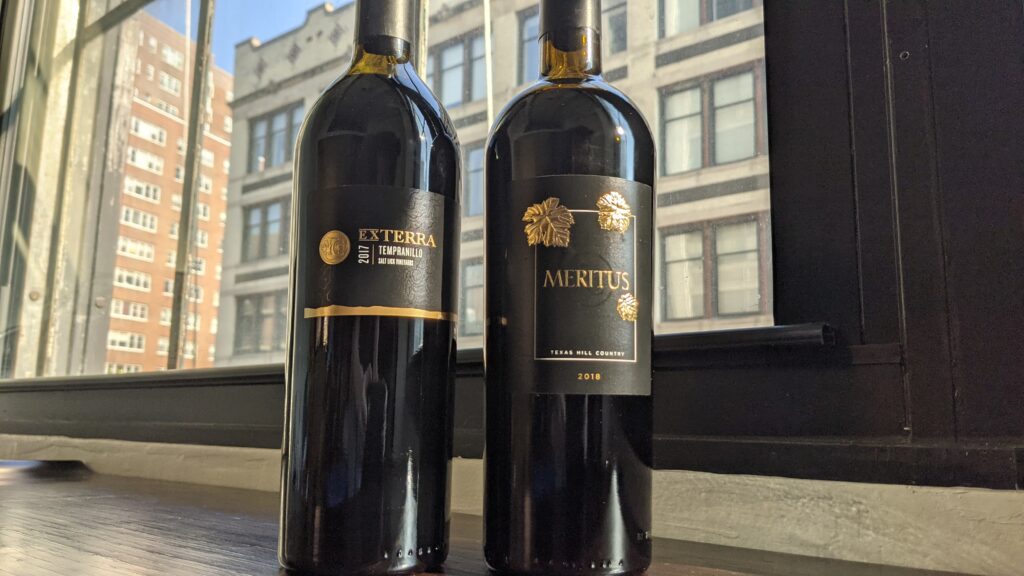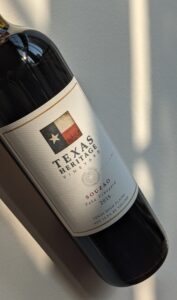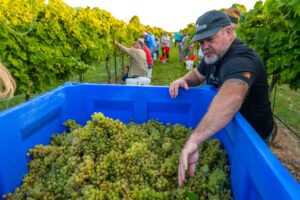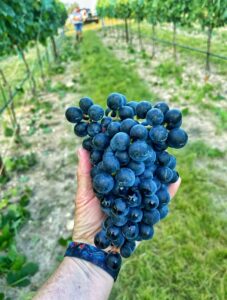Texas ranchers Ed and Susan Auler’s lives wound up taking a completely different course during a trip to France in 1973 while they were looking into French cattle breeds to potentially cross with their Angus herd as well as learning different ranching techniques. But the wine and food of Burgundy and Bordeaux, as well as many other regions of France, enchanted them with their charm, beauty and sense of community. They ended up becoming one of the founding families of the Texas post-prohibition wine industry as they started to make wine from test vineyards at the University of Texas and today, Susan says they still make the Chenin Blanc and Sauvignon Blanc over 40 years later from those same vineyards with their Fall Creek Vineyards.
The state of Texas is actually a little larger (in area) than France and has as much diversity when it comes to its varying topography and so the Auler’s time in France, which they ended up traveling there every year, taught them that defining specific areas with an appellation status would be key for the future of a wine region; and hence they established the Texas Hill Country AVA (American Viticultural Area) which today is the most well-known wine area in Texas.
Susan talked about how wonderful it was to start in the 1970s as the food and wine scene was so small that everyone knew everyone and hence why legends such as André Tchelistcheff (the most influential post-prohibition American winemaker) came out to check their vineyards and told Ed and Susan that he thought it was a great idea to plant vineyards in Hill Country; today their ‘Meritus’ wine is dedicated to André as he inspired them to fully commit to investing in vineyards. In 2013 they took another major leap with their Fall Creek winery by bringing onboard Sergio Cuadra as director of winemaking, a recommendation from their friend Paul Hobbs, and his experience of working with various types of vineyards with Concha y Toro as well as working with the fine wines of Errazuriz’s Caliterra in Chile made him an ideal choice to bring out the various terroirs (sense of place) in the diverse landscape of Texas.
What started out as Fall Creek Vineyards and a couple other wineries experimenting with university plots back in the ‘70s has turned into a fast growing industry with not only adventurous people coming from all over the world to explore working the vineyards in a state that grows a multitude of grape varieties but wine tourism itself has become one of the fastest growing businesses in Texas Hill Country.
Texas Heat
Sergio made the case for Texas as that it was mistakenly once considered a hostile place for wine grapes, and not that they don’t have their challenges like all wine regions, but that some of the varieties they work with do quite well in the heat. He makes the point that many grape varieties that are used for winemaking today can be traced to origins coming from the Middle East area around 6,000-8,000 years ago as archaeologists have found proof of winemaking existing in that area during those times. And he has compared temperature charts from those Middle East areas during those times with today’s Central Texas climate and he notes that they are very similar. So in his mind many of these grapes are made for the kind of heat that they get with summer temperatures that are 95 Fahrenheit and above during the day and 80 Fahrenheit at night in some parts of the Hill Country. Although he hasn’t proved it, he is sure that some vines have it in their DNA to adapt to the heat once it kicks in during the spring and hence why they survive the extremely hot summer months.
But with that said, Texas has a diverse climate and topography throughout and just within the Texas Hill Country in Central Texas the weather can vary from arid to humid, from cooler temperatures to fierce heat, from lots of sun to lots of overcast weather and among that is a plethora of soil types and structures that range from being relatively young to over a billion years old according to Sergio; Hill Country itself is nine million acres in size with only 1,000 acres planted with vineyards so far. And that is why Fall Creek has been able to make award winning wines from different varieties such as their single vineyard Chardonnay with lots of finesse and elegance, single vineyard Tempranillo that is earthy and complex to their ‘Meritus’ Bordeaux-blend that displays the multifaceted layers of blending sites.
But the founders of Hill Country such as Fall Creek are not the only ones getting accolades for their wines but a young startup founded by Susan Johnson with her husband Billy has received awards as well. The Johnsons planted their first grapevines in 2015 and built their winery Texas Heritage Vineyard in 2017 and then they won Best of Class for their 2018 Barbera and Double Gold for their 2018 Souzão with four other medals from the 2021 San Francisco Chronicle Wine Competition. After 31 years in the corporate world, Susan retired and with her husband moved from Austin to Fredericksburg, the most popular wine tourist destination in Hill Country, to pursue their agricultural dreams. After a lavender farm didn’t work out, Susan decided to enroll in a viticulture program and during one fateful trip to Napa Valley, as they were on a mission to visit small, successful wineries there to mull over whether getting into the wine business was a good idea, they took the leap and purchased 3,600 vines after drinking too much great Napa wine; most people who visit Napa join a wine club but the Johnsons went all in to becoming wine grape growers.
The Texas state flag displayed on the Texas Heritage Vineyard label really evokes that Texas adventurous spirit, “up for anything” attitude and willingness to do the backbreaking work needed that Susan and her husband perfectly represent; although Susan’s husband still works full time, often times he is helping out in the winery during the weekends doing “cellar rat duty” and spending most weeknights during harvest time helping out in the vineyards. Susan juggles many different jobs and just one of them is working with their winemaker to decide on harvest dates, blends and which vineyards they are going to purchase as they are still waiting on many of their estate vineyards to reach a certain maturity. Despite Susan noting that they want to move towards bottling 100% Hill Country fruit, she did decide to purchase from the Texas High Plains (a huge plateau reaching up to 5,000 feet in elevation and it is drier than Hill Country with cooler nights) in the North West portion of the state this year because she couldn’t pass up working with Mourvèdre for the first time as well as Albariño – they are making an unoaked and oaked version as well as a pét-nat (low in alcohol, slightly sparkling wine that is unfined and unfiltered).
The pét-nat came about after something went wrong with one of their chillers for their tanks and so they turned their tank room down to 55 Fahrenheit until they could get someone out to fix it but because of that slight rise in temperature that tank of Albariño was right at the place it needed to be for a pét-nat and so they bottled it. It is called Spindletop after where the first major oil gusher happened in Texas in anticipation that one of the bottles may explode since the wine is unfiltered and has some residual sugar – none have exploded yet while the bottles rest in their cellar but as Susan said, “We are up for trying anything and so we will see what happens.”
Rock Star Mentoring A New Generation
Texas Heritage brought in veteran winemaker John Rivenburgh to consult for their 2017 and 2018 vintages before they hired a fulltime winemaker and John has become one of the biggest names on the Texas wine scene. He is currently president of Texas Hill Country Wineries, a long-time advocate for sustainable practices, an award-winning winemaker and basically the guy that everyone watches to see what works and doesn’t work. Many wine producers have hired John as a consultant and he currently manages just under a couple hundred acres of vineyards in the state of Texas with 60 more acres coming under his management next year; in the past couple of years he has made around 39 varieties from 27 different vineyards for each vintage.
In 2019, John bought Kerrville Hills Winery located in the quaint, charming town of Kerrville which is a 30 minute drive south of the much more famous tourist destination Fredericksburg. But he makes the case for Kerrville being a must-see to visit as it has tons of art galleries, an old art deco theater that overlooks a river and has stunning walking trails along the river with gorgeous cypress and live oak trees, just to name a few things that make it special. “It is a cool town that is artistically and culturally one of the most advanced in Hill Country,” John said with pride. And although he admits that at first he bought Kerrville Hills, the first winery in Kerrville, so he could build up the name with some great wines to then eventually sell for a profit, he ended up falling in love with the town and people.
After he bought Kerrville Hills and felt that this was going to become his home, he realized how much he loved teaching others and so he started an incubator to help people make their Texas winery dreams come true. Then Covid hit and he talked about how “2020 was financially a pretty scary time” but the idea that he had so many people calling him because they wanted to learn how to make wine or start a winery in the middle of a pandemic was “pretty amazing”. It really showed that the Texas wine industry was on an unstoppable upward rise and it couldn’t even be halted by the coronavirus.
Throughout his experience, John has seen some grape varieties and/or clones (different mutations of a variety) that just crash in Hill Country heat and others that are able to adapt. His philosophy is that Mother Nature will show a grower what works and doesn’t work and Texas grape growers are starting to get on a better track of what is best for various vineyard plots. And he feels that Hill Country, which has been dependent on buying a significant amount of grapes in the past from the High Plains, is becoming independent with its own vineyards and that it is on the cusp of really jumping off as its own wine region; although he admits that he will always buy grapes from the High Plains as certain grapes just do a lot better up there.
Defining Texas Wine
John has been fortunate enough to travel all over the world consulting and working with other wine producers and he understands that many wine regions hang their hat on a couple of varieties that make it easier for them to gain notoriety. But the sheer size of Texas with its great amount of diversity, Hill Country itself could be broken up into several sub-regions, really lends itself to a wide range of grape varieties being used and some grapes in his mind have done better in Texas than anywhere else in the world such as the extremely tannic grape variety Tannat. As many in the Texas wine industry know, John is basically the king of Tannat and he has worked all over the world, as well as all over Texas, helping people with their lots of Tannat. At last count he has worked with 195 different Tannats and he doesn’t use micro-oxygenation but uses other protocols for taming the tannins in Tannat that could range from maceration techniques to timing of adding nutrients to barrel aging but it is different with each plot. “Texas Tannat is like the Goldilocks of Tannat”, noted John as it has “a little bit of fruit, a little bit of acid, well integrated tannins” and he feels that they have found the one place where it does a great job on its own.
But with that said, he doesn’t want to get to the place where a wine producer has to make a Tannat or other well-known Texas wines like Tempranillo or Piquepoul Blanc, as it not only goes against the richness of the diverse topography of Texas to rest only on one variety but as John expressed, “touting our diversity is just ingrained in us as Texans.”
And as everyone else jumped on the bandwagon of making the thirst-quenching Piquepoul Blanc when John started doing it, he then decided to search for those plots that could make age-worthy white wines. And he had been working with a special plot of Sémillon that has nice freshness with beautiful fruit with some honey and spice but not too heavy that he decided to age mainly in used oak. He honestly admitted that he doesn’t know why that plot grows such a well-balanced Sémillon but it just fits into the Texas theme that once one has felt like he has figured Texas out something comes along to break that perception.
It is never going to be easy to just put Texas under one stereotype of making a certain type of wine as John noted that they break stereotypes every day in Hill Country; when people come out and it is not only the wines that challenge their perceptions but the diversity of independent thinking people, the wealth of arts and culinary delights that can be found in Austin and San Antonio and everywhere in between really surprises people in the best ways. “I know we don’t get the greatest rap outside of Texas,” said John but he promised that Hill Country was very different from what most people would expect.
But the enormous task of figuring out all the potential vineyard nuances of Hill Country, let alone Texas, doesn’t escape John as he says with an easy smile, “It may take us one hundred years” but they will eventually figure out all of those nuances and he figured it would be his children’s children that would figure it out.
Thinking back over 45 years ago, when Ed and Susan Auler were inspired by their trips to France to start growing grapes and building a winery in Texas Hill Country, one day, maybe when John’s grandchildren are leading the way with other multi-generational Hill Country wine producers, Texas will be a world-renowned wine region of its own that will inspire others with its independent and adventurous spirit and love for diversity to go against the grain.
***This article was originally published on Forbes: https://www.forbes.com/sites/cathrinetodd/2021/10/09/texas-wines-show-adventurous-spirit-and-love-for-diversity/

Photo Credit: Cathrine Todd
Fall Creek Vineyards
2019 Fall Creek Vineyards Chardonnay, Certenberg Vineyards, Texas Hill Country, Texas: 100% Chardonnay. Golden color with notes of hazelnut, pristine white peach and apricot flavors with a stony minerality that had bright acidity that was balanced by a moderately creamy texture that finished with orange blossoms. Sometimes it can be quite boring or disappointing to taste Chardonnay from emerging wine regions but I have to say that this one was quite impressive as it was perfectly balanced while hitting all the pleasure centers.
2017 Fall Creek Vineyards ‘Ex Terra’, Salt Lick Vineyards, Texas Hill Country, Texas: 100% Tempranillo. Fresh leather, dark chocolate with freshly dug earth with blueberry pie, singed thyme and finely etched tannins; a super star Tempranillo; decant for an hour.
2018 Fall Creek Vineyards ‘Meritus’ Texas Hill Country, Texas: 50% Merlot and 12.5% Petit Verdot from Certenberg Vineyards and 37.5% Cabernet Sauvignon from Salt Lick Vineyards. Smoldering earth, charred oak and blackcurrants that had rich cherry flavors with hints of cigar box and savory spices that had a juicy mid-palate with some grip. A lovely homage to André Tchelistcheff; decant for an hour.
Texas Heritage Vineyard
2018 Texas Heritage Vineyard, Barbera, Texas High Plains AVA, Texas: 100% Barbera. Bright medium ruby color, red cherries, dried flowers, fresh acidity, moderate weight, good fleshy round tannins. Simply delicious.
2018 Texas Heritage Vineyard, Souzao, Texas High Plains AVA, Texas: 100% Souzão. Opaque color with hints of purple and the nose has notes of tar, cocoa powder and cherry pie balanced with plenty of earthiness with wet clay and a underlying mineral note that is lifted by the bright acidity; well-managed tannins and the wine overall has intense concentration yet wrapped up in a delivery with lots of finesse. Impressive.
Kerrville Hills Winery
2019 Kerrville Hills Winery, Sémillon, Kerrville in Hill Country, Texas: 100% Sémillon. The nose has aromas of honeysuckle, golden apples, toasted spices and roasted almonds with medium body and rich peach and apricot flavors with fresh acidity. An addictive wine.
2017 Kerrville Hills Winery, Tannat, Kerrville in Hill Country, Texas: 100% Tannat. Does not use micro-oxygenation but through maceration techniques and nutrition during fermentation he has developed a way to tame the tannins in Tannat. Deep inky color with a nose that sings of dried blueberries and boysenberry pie with a hint of vanilla bean with a mineral edge that had silky tannins and a round texture with juicy black and blue fruits, plums as well, with spice cake and crushed rocks intermixed giving more complexity. Who knew that a 100% Tannat could be so beautifully balanced?!



















